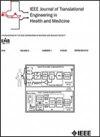Measurement of Peripheral Nerve Magnetostimulation Thresholds of a Head Solenoid Coil Between 200 Hz and 88.1 kHz
IF 4.4
3区 医学
Q2 ENGINEERING, BIOMEDICAL
IEEE Journal of Translational Engineering in Health and Medicine-Jtehm
Pub Date : 2025-03-15
DOI:10.1109/JTEHM.2025.3570611
引用次数: 0
Abstract
Magnetic fields switching at kilohertz frequencies induce electric fields in the body, which can cause peripheral nerve stimulation (PNS). Although magnetostimulation has been extensively studied below 10 kHz, the behavior of PNS at higher frequencies remains poorly understood. This study aims to investigate PNS thresholds at frequencies up to 88.1 kHz and to explore deviations from the widely accepted hyperbolic strength-duration curve (SDC).PNS thresholds were measured in the head of 8 human volunteers using a solenoidal coil at 16 distinct frequencies, ranging from 200 Hz to 88.1 kHz. A hyperbolic SDC was used as a reference to compare the frequency-dependent behavior of PNS thresholds.Contrary to the predictions of the hyperbolic SDC, PNS thresholds did not decrease monotonically with frequency. Instead, thresholds reached a minimum near 25 kHz, after which they increased by an average of 39% from 25 kHz to 88.1 kHz across subjects. This pattern indicates a significant deviation from previously observed behavior at lower frequencies.Our results suggest that PNS thresholds exhibit a non-monotonic frequency dependence at higher frequencies, diverging from the traditional hyperbolic SDC. These findings offer critical data for refining neurodynamic models and provide insights for setting PNS safety limits in applications like MRI gradient coils and magnetic particle imaging (MPI). Further investigation is needed to understand the biological mechanisms driving these deviations beyond 25 kHz.头部电磁线圈200 ~ 88.1 kHz周围神经磁刺激阈值的测量
以千赫兹频率转换的磁场会在体内产生电场,从而引起周围神经刺激(PNS)。尽管在10khz以下的磁刺激已经得到了广泛的研究,但PNS在更高频率下的行为仍然知之甚少。本研究旨在研究频率高达88.1 kHz的PNS阈值,并探索与广泛接受的双曲强度-持续时间曲线(SDC)的偏差。使用螺线管线圈,在200赫兹到88.1千赫的16种不同频率下,测量了8名人类志愿者的PNS阈值。使用双曲SDC作为参考,比较PNS阈值的频率依赖性行为。与双曲SDC的预测相反,PNS阈值并没有随频率单调降低。相反,阈值在25 kHz附近达到最低,之后,受试者的阈值从25 kHz平均增加39%至88.1 kHz。这种模式表明在较低频率下与先前观察到的行为有显著偏差。我们的研究结果表明,PNS阈值在更高的频率下表现出非单调的频率依赖性,与传统的双曲SDC不同。这些发现为完善神经动力学模型提供了关键数据,并为在MRI梯度线圈和磁颗粒成像(MPI)等应用中设置PNS安全限制提供了见解。需要进一步的研究来了解导致这些偏差超过25 kHz的生物学机制。临床影响:这些发现要求对高频PNS阈值趋势的生物学机制进行进一步的基础研究,并支持完善MRI和MPI系统的临床应用安全指南。
本文章由计算机程序翻译,如有差异,请以英文原文为准。
求助全文
约1分钟内获得全文
求助全文
来源期刊

IEEE Journal of Translational Engineering in Health and Medicine-Jtehm
Engineering-Biomedical Engineering
CiteScore
7.40
自引率
2.90%
发文量
65
审稿时长
27 weeks
期刊介绍:
The IEEE Journal of Translational Engineering in Health and Medicine is an open access product that bridges the engineering and clinical worlds, focusing on detailed descriptions of advanced technical solutions to a clinical need along with clinical results and healthcare relevance. The journal provides a platform for state-of-the-art technology directions in the interdisciplinary field of biomedical engineering, embracing engineering, life sciences and medicine. A unique aspect of the journal is its ability to foster a collaboration between physicians and engineers for presenting broad and compelling real world technological and engineering solutions that can be implemented in the interest of improving quality of patient care and treatment outcomes, thereby reducing costs and improving efficiency. The journal provides an active forum for clinical research and relevant state-of the-art technology for members of all the IEEE societies that have an interest in biomedical engineering as well as reaching out directly to physicians and the medical community through the American Medical Association (AMA) and other clinical societies. The scope of the journal includes, but is not limited, to topics on: Medical devices, healthcare delivery systems, global healthcare initiatives, and ICT based services; Technological relevance to healthcare cost reduction; Technology affecting healthcare management, decision-making, and policy; Advanced technical work that is applied to solving specific clinical needs.
 求助内容:
求助内容: 应助结果提醒方式:
应助结果提醒方式:


